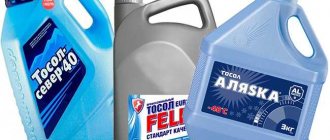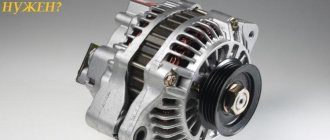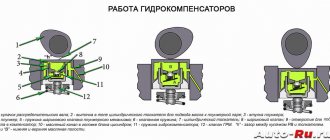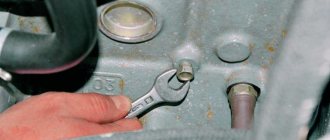Every car uses an internal combustion engine. Liquid cooling systems have become widespread - only the old Zaporozhets and new Tatas use air blowing. It should be noted that the coolant circulation scheme on all machines is almost similar - the same elements are present in the design, they perform identical functions.
Small cooling circle
In the cooling system circuit of an internal combustion engine, there are two circuits - small and large. In some ways it is similar to human anatomy - the movement of blood in the body. The liquid moves in a small circle when it is necessary to quickly warm up to operating temperature. The problem is that the motor can function normally in a narrow temperature range - about 90 degrees.
Large cooling circuit
In this case, the main radiator is also included in the engine cooling system circuit. It is installed in the front of the car and is designed to urgently reduce the temperature of the fluid in the engine. If the car has an air conditioner, then its radiator is installed nearby. On Volga and Gazelle cars, an oil cooler is used, which is also installed in the front of the car. The radiator is usually equipped with a fan, which is driven by an electric motor, belt or clutch.
What is coolant?
Its other names are coolant, antifreeze, radiator fluid. Its main purpose is to control the temperature of engine parts and fluids under different weather conditions. Coolant for cars is a substance with additives that allow it to maintain a liquid state at low temperatures (less than 0°C), as well as at high temperatures (more than 100°C), preventing it from evaporating. It must have anti-corrosion properties, protecting the metal surfaces of the engine and its parts.
Coolant composition
These products are based on a glycol-water mixture, thanks to which they acquire their basic properties: frost resistance, viscosity, optimal specific heat capacity. Coolants based on ethylene glycol are more common. An aqueous solution of this substance has an aggressive effect on the parts of the cooling system. Because of this, additives are added to the coolant:
- stabilizing;
- antifoaming;
- anti-corrosion.
What is coolant used for?
The refrigerant performs a number of functions. The frequency of replacement and volume of coolant are individual for each car. This must be done in a timely manner, taking into account what important tasks it performs:
- cooling of car engine components;
- thanks to antifreeze, the engine water pump through which antifreeze is supplied is lubricated;
- cooling the hydraulic fluid contained in the automatic transmission;
- heating the car interior in the cold season.
Liquid pump in the system
This device is included in the coolant circulation circuit of the Gazelle and any other car. The drive can be carried out as follows:
- From the timing belt.
- From the generator belt.
- From a separate belt.
The structure consists of the following elements:
- Metal or plastic impeller. The efficiency of the pump depends on the number of blades.
- Housing - usually made of aluminum and its alloys. The fact is that this particular metal works well in aggressive conditions; corrosion has practically no effect on it.
- The pulley for installing the drive belt is toothed or wedge-shaped.
- The shaft is a steel rotor, at one end of which there is an impeller (inside), and on the outside there is a pulley for installing the drive pulley.
- Bronze bushing or bearing - these elements are lubricated using special additives found in antifreeze.
- The oil seal prevents fluid from leaking out of the cooling system.
Types of coolant
The correct choice of this substance is the key to the correct operation of the car’s cooling system. There are the following types of antifreeze:
- traditional;
- hybrid;
- carboxylate;
- lobrid.
Traditional antifreeze
This type of refrigerant is considered obsolete. This also includes antifreeze for cars - a type of coolant developed during the USSR. It was used for Soviet car brands - Volga, Moskvich, Zhiguli. A representative of such liquids is g11 antifreeze. In Europe, such refrigerants stopped being produced in the 90s. There are traditional antifreezes on the modern market, but they should be used with caution - there is no guarantee that they will not negatively affect car parts. These liquids contain inorganic components:
- silicates;
- borates;
- phosphates;
- amines;
- nitrites;
- nitrates.
Hybrid antifreeze
These liquids belong to class g11 and are produced using modern bipolar technologies. More often it is yellow or orange antifreeze. The main difference between such liquids is the creation of a thin film that protects the surfaces of engine parts from corrosion when corrosion occurs. Due to the use of long-term inhibitors for their manufacture, reliable operation of the vehicle’s cooling system is ensured in all weather conditions.
Carboxylate antifreeze
This variety is called organic due to the presence of organic acids in its composition. It does not contain nitrites, nitrates, silicates, amines, or phosphates. More often it is a red antifreeze, characterized by a slow but prolonged effect of inhibitors. Such liquids are characterized by a high boiling point and a service life of 5 years. Antifreeze g12 red contains anti-corrosion substances that promote the formation of a thin protective film. The product is used for both domestic and foreign cars.
Lobrid antifreeze
These are g12++ class liquids with a purple color and excellent performance. They contain minerals and organic inhibitors. This car antifreeze also contains silicates, which form a protective anti-corrosion film on the surface of the cooling system spare parts. The organic substances that make up the liquid have an effect on areas where rust has already appeared. When using lobrid antifreeze for a new car, the life of the coolant is unlimited.
Thermostat and its features
It is difficult to say which element ensures the most efficient circulation of fluid in the cooling system. On the one hand, the pump creates pressure and antifreeze moves through the pipes with its help.
But on the other hand, if there were no thermostat, the movement would occur exclusively in a small circle. The design contains the following elements:
- Aluminum housing.
- Outputs for connecting to pipes.
- Bimetal type plate.
- Mechanical valve with return spring.
The principle of operation is that at temperatures below 85 degrees the liquid moves only along a small circuit. In this case, the valve inside the thermostat is in a position in which antifreeze does not enter the large circuit.
As soon as the temperature reaches 85 degrees, the bimetallic plate will begin to deform. It acts on the mechanical valve and allows antifreeze access to the main radiator. As soon as the temperature drops, the thermostat valve will return to its original position under the action of the return spring.
Leaks and problems
The main problems in the cooling system of the AUDI 80 B3, B4 are related to leaks that can form in the hoses, radiator and interior heater. Also, the pump and thermostat often fail, which, if a malfunction is detected, simply need to be replaced.
There is a problem with the cylinder head gasket burning, in which case coolant enters the combustion chamber. This can be determined by the bubbling in the expansion tank created by the exhaust gases.
You can also pay attention to the color of the smoke coming out of the exhaust pipe. If it is white, as if with clouds of steam, while antifreeze escapes, but there are no leaks, then the problem is probably a damaged gasket.
Expansion tank cap
Another irreplaceable component of the system is the plug. There are two types of construction - sealed and non-sealed. If the latter is used on the car, the expansion tank plug has only a drainage hole through which the pressure in the system is balanced.
But if a sealed system is used, then there are two valves in the plug - an inlet (takes air inside from the atmosphere, operates at a pressure below 0.2 bar) and an outlet (operates at a pressure above 1.2 bar). It removes excess air from the system.
It turns out that the pressure in the system is always greater than in the atmosphere. This allows you to slightly increase the boiling point of the antifreeze, which has a beneficial effect on engine performance. This is especially good for driving through traffic jams in urban environments. An example of a sealed system is VAZ-2108 and similar cars. Unsealed - models of the classic VAZ series.
Radiator and fan
The coolant circulates through the main radiator, which is installed at the front of the car. This location was not chosen by chance - when driving at high speed, the radiator honeycombs are blown by a counter flow of air, which reduces the engine temperature. A fan is installed on the radiator. Most of these devices are electrically driven. On Gazelles, for example, clutches similar to those installed on air conditioning compressors are often used.
The electric fan is turned on using a sensor installed at the bottom of the radiator. On injection machines, the signal from the temperature sensor, which is located on the thermostat housing or in the engine block, can be used. The simplest switching circuit contains only one thermal switch - its contacts are normally open. As soon as the temperature at the bottom of the radiator reaches 92 degrees, the contacts inside the switch will close and voltage will be supplied to the fan motor.
Interior heater
This is the most important part when viewed from the driver and passengers' perspective. Comfort when driving in the winter season depends on the efficiency of the stove. The heater is part of the coolant circulation circuit and consists of the following components:
- Electric motor with impeller. It is turned on according to a special circuit in which there is a constant resistor - it allows you to change the rotation speed of the impeller.
- The radiator is the element through which hot antifreeze passes.
- The tap is designed to open and close the supply of antifreeze inside the radiator.
- The duct system allows you to direct hot air in the desired direction.
The coolant circulation pattern through the system is such that if only one inlet to the radiator is closed, hot antifreeze will not get into it in any way. There are cars in which there is no heater tap - there is always hot antifreeze inside the radiator. And in the summer, the air ducts simply close and no heat is supplied to the cabin.
Read US on VKontakte
What coolant should I fill?
Different types of antifreeze are used for different cars. The best option is to select coolant according to the make of the car. Manufacturers indicate which antifreeze is suitable for a particular brand. For example, class g11 refrigerant is recommended for use in the following vehicles:
- Alfa Romeo (years of production - from 1976 to 2005);
- Audi (years of production - from 1981 to 1996);
- Bentley (years of production – from 1980 to 2005);
- BMW (years of production – from 1975 to the present);
- Chrysler (years of production – from 1985 to the present);
- Daewoo (all models);
- Fiat (years of production - from 1982 to 2005);
- Ford (years of production - from 1977 to 1998);
- Lada (all models);
- Opel (years of production – from 1975 to 2000);
- Volkswagen (years of production - from 1975 to 1997);
- Volvo (all models).
Coolant class g12 is used for the following brands:
- Alfa Romeo (years of production – from 2005 to the present);
- Audi (years of production – from 1996 to the present);
- Bentley (years of production – from 2005 to the present);
- Citroën (all models);
- Daihatsu (all models);
- Ford (years of production – from 1998 to the present);
- Honda (all models);
- Hyundai (all models);
- KIA (all models);
- Lexus (all models);
- Mazda (all models).
Coolant rating
There are manufacturers whose products have proven themselves to be of high quality. The top coolant is compiled taking into account user preferences:
- Lukoil Antifreeze G12 Red 5L
. The leader in the rating is produced using carboxylate technology and reliably protects the engine from overheating and scale formation. - Felix Energy G12 + 1L
. Domestic antifreeze used for all types of cars. The product can be used in the temperature range from -40 to +50°C. - AGA Z65 5L
. Universal engine coolant used for trucks and cars. Temperature range from -65 to +132°С, service life – 5 years. - CoolStream Optima
. A universal product that is suitable for any cooling system: both for domestic cars and for foreign cars. Temperature range from -42 to +109°С, service life – 2 years. - Felix Carbox G12
. Domestic antifreeze that can be used for engines of any type.











